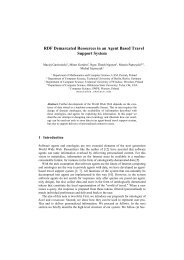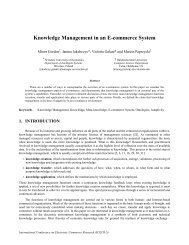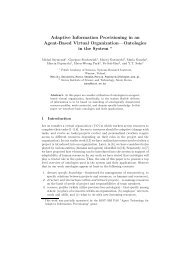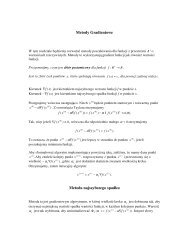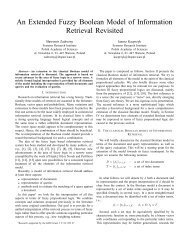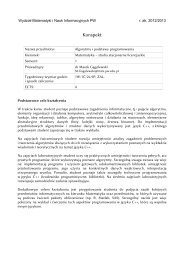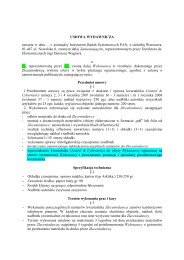Statistical Kernel Estimators for Data Analysis and ... - ResearchGate
Statistical Kernel Estimators for Data Analysis and ... - ResearchGate
Statistical Kernel Estimators for Data Analysis and ... - ResearchGate
Create successful ePaper yourself
Turn your PDF publications into a flip-book with our unique Google optimized e-Paper software.
RECENT ADVANCES in APPLIED MATHEMATICS<br />
<strong>Statistical</strong> <strong>Kernel</strong> <strong>Estimators</strong> <strong>for</strong> <strong>Data</strong> <strong>Analysis</strong> <strong>and</strong> Exploration Tasks –<br />
Theory <strong>and</strong> Applications<br />
PIOTR KULCZYCKI *<br />
Center <strong>for</strong> <strong>Statistical</strong> <strong>Data</strong> <strong>Analysis</strong> Methods (Head)<br />
Systems Research Institute<br />
Polish Academy of Sciences<br />
ul. Newelska 6, PL-01-447 Warsaw<br />
POLAND<br />
kulczycki@ibspan.waw.pl http://www.ibspan.waw.pl/kulczycki<br />
Abstract: - At present, statistical kernel estimators constitute the dominant – in practice – method of nonparametric<br />
estimation. It allows the useful characterization of probability distributions without arbitrary assumptions regarding<br />
their membership to a fixed class. In this paper their use to the basic tasks of data analysis <strong>and</strong> exploration,<br />
i.e. identification of outliers, clustering, <strong>and</strong> classification, will be considered. In every case the final result will be an<br />
algorithm ensuring that its practical implementation does not dem<strong>and</strong> of the user detailed knowledge of the theoretical<br />
aspects, or laborious research <strong>and</strong> calculations. The above presented theory has been successfully applied to various<br />
practical problems of engineering <strong>and</strong> management. Two of these, the design of a fault detection <strong>and</strong> diagnosis system<br />
<strong>for</strong> automatic control purposes, <strong>and</strong> a marketing support strategy <strong>for</strong> a mobile phone operator, will be demonstrated in<br />
detail. Useful procedures <strong>for</strong> the reduction of dimensionality <strong>and</strong> size of a r<strong>and</strong>om sample, subordinated to the<br />
specificity of kernel estimators, will also be commented.<br />
Key-Words: - In<strong>for</strong>mation technology, <strong>Data</strong> analysis <strong>and</strong> exploration, Nonparametric estimation, <strong>Kernel</strong> estimators,<br />
Automatic control, Fault detection, Decision support, Marketing strategy<br />
1 Introduction<br />
Thanks to the dynamic development in contemporary<br />
computer systems, the range <strong>for</strong> practical application of<br />
nonparametric methods <strong>for</strong> identification <strong>and</strong> estimation<br />
is constantly growing. While the classical parametrical<br />
procedures arbitrarily assume the <strong>for</strong>m of the function<br />
under investigations <strong>and</strong> then specify its parameters, the<br />
nonparametric methods do not require any such kind of<br />
limiting assumption.<br />
The subject of this paper, currently dominant among<br />
nonparametric methods, is kernel estimators, mainly<br />
used to identify the most universal characteristic of a<br />
r<strong>and</strong>om variable – its distribution density. Here also is<br />
presented the application of this type of estimators in<br />
some basic tasks of data analysis <strong>and</strong> exploration –<br />
recognition of atypical elements (outliers), clustering,<br />
<strong>and</strong> classification – used next as examples in fault<br />
detection <strong>and</strong> diagnosis of industrial devices working in<br />
a real-time regime, <strong>and</strong> then to define a marketing<br />
support strategy <strong>for</strong> a mobile phone operator.<br />
The following text also contains results of research in<br />
the field of kernel estimators carried out together with<br />
* Also: Cracow University of Technology, Department<br />
of Automatic Control (Head), ul. Warszawska 24,<br />
PL-31-155 Cracow, Pol<strong>and</strong>, e-mail: kulczycki@pk.edu.pl,<br />
http://www.control.pk.edu.pl/kulczycki .<br />
M. Charytanowicz, K. Daniel, P.A. Kowalski, S. Lukasik,<br />
A. Mazgaj, C. Prochot, J. Waglowski, <strong>and</strong> S. Zak. This<br />
material was presented more broadly in the survey works<br />
[7, 8, 10, 12].<br />
2 <strong>Kernel</strong> <strong>Estimators</strong><br />
Let the n-dimensional r<strong>and</strong>om variable X : Ω → R ,<br />
with a distribution having the density f, be given. Its<br />
kernel estimator ˆ n<br />
f : R → [0, ∞)<br />
is calculated on the<br />
basis of the m-elements simple r<strong>and</strong>om sample x 1,<br />
x 2 , ..., x m , experimentally obtained from the variable X,<br />
<strong>and</strong> is defined in its basic <strong>for</strong>m by the <strong>for</strong>mula<br />
m<br />
⎛ x − xi<br />
⎞<br />
f ˆ 1<br />
( x)<br />
= ∑ K⎜<br />
⎟<br />
n<br />
mh ⎝ h<br />
, (1)<br />
⎠<br />
i=<br />
1<br />
where the measurable, symmetrical with respect to zero<br />
<strong>and</strong> having a weak global maximum in this point,<br />
n<br />
function K : R → [0, ∞)<br />
fulfils the condition<br />
∫ n<br />
K( x)<br />
dx<br />
= 1 <strong>and</strong> is called a kernel, whereas the<br />
R<br />
positive coefficient h is referred to as a smoothing<br />
parameter. It is worth noting that a kernel estimator<br />
allows the identification of density <strong>for</strong> practically every<br />
distribution, without any assumptions concerning its<br />
n<br />
ISSN: 1790-2769 257 ISBN: 978-960-474-138-0
RECENT ADVANCES in APPLIED MATHEMATICS<br />
membership to a fixed class. Atypical, complex<br />
distributions, also multimodal, are regarded here as<br />
textbook unimodal. In the multidimensional case this<br />
enables, among others, the discovery of total<br />
dependences between particular coordinates of the<br />
r<strong>and</strong>om variable under investigation.<br />
Setting of the quantities introduced in definition (1),<br />
i.e. choice of the <strong>for</strong>m of the kernel K as well as<br />
calculation of the value <strong>for</strong> the smoothing parameter h, is<br />
most often carried out according to the criterion of<br />
minimum of an integrated mean-square error. Broader<br />
discussion <strong>and</strong> practical algorithms are found in the<br />
books [8; 22, 23] 1 . In particular, the choice of the kernel<br />
<strong>for</strong>m has no practical meaning <strong>and</strong> thanks to this it is<br />
possible to take into account primarily properties of the<br />
estimator obtained (e.g. its class of regularity, boundary<br />
of a support, etc.) or aspects of calculations,<br />
advantageous from the point of view of the applicational<br />
problem under consideration. Practical applications may<br />
also use additional procedures, some generally<br />
improving the quality of the estimator, <strong>and</strong> others –<br />
optional – possibly fitting the model to an existing<br />
reality. For the first group one should recommend the<br />
modification of the smoothing parameter [8 – Section<br />
3.1.6; 22 – Section 5.3.1] <strong>and</strong> a linear trans<strong>for</strong>mation [8<br />
– Section 3.1.4; 22 – Section 4.2.1], while <strong>for</strong> the<br />
second, the boundaries of a support [8 – Section 3.1.8;<br />
22 – Section 2.10].<br />
<strong>Kernel</strong> estimators allow effective modeling of the<br />
distribution density – a basic functional characteristic of<br />
r<strong>and</strong>om variables. Consequently this is fundamental in<br />
obtaining other functional characteristics <strong>and</strong> parameters.<br />
For example, if in a one-dimensional case the kernel K is<br />
such chosen that its primitive I( x)<br />
= ∫ x K(<br />
y)<br />
dy<br />
may be<br />
−∞<br />
analytically obtained, then the estimator of the<br />
distribution function<br />
m<br />
⎛ x − xi<br />
⎞<br />
F ˆ 1<br />
( x)<br />
= ∑ I⎜<br />
⎟<br />
m ⎝ h ⎠<br />
(2)<br />
i=<br />
1<br />
can be easy calculated. Next, if the kernel K has (strictly)<br />
positive values, the solution <strong>for</strong> the equation<br />
F ˆ ( x)<br />
= r<br />
(3)<br />
constitutes the kernel estimator of quantile of the order<br />
r ∈(0,1) . For details <strong>and</strong> proofs of strong consistencies<br />
see [18].<br />
1 For calculating a smoothing parameter one can especially<br />
recommend the plug-in method in the one-dimensional case [8<br />
– Section 3.1.5; 22 – Section 3.6.1], as well as the crossvalidation<br />
method [8 – Section 3.1.5; 21 – Section 3.4.3] in the<br />
multidimensional. Comments <strong>for</strong> the choice of kernel may<br />
best be found in [8 – Section 3.1.3; 22 – Sections 2.7 <strong>and</strong> 4.5].<br />
It is worth mentioning also the possibility of applying<br />
data compensation <strong>and</strong> dimensionality reduction<br />
procedures – original <strong>and</strong> useful algorithms can be found<br />
in the book [21 – Sections 2.5 <strong>and</strong> 3.4]. A specialized<br />
algorithm, based on simulated annealing, <strong>and</strong> dedicated<br />
to data analysis <strong>and</strong> exploration procedures found in the<br />
next chapter, is being researched – preliminary results<br />
are presented in the work [19].<br />
3 <strong>Data</strong> <strong>Analysis</strong> <strong>and</strong> Exploration<br />
The application of kernel estimators <strong>for</strong> recognition of<br />
atypical elements, clustering, <strong>and</strong> classification will be<br />
subsequently investigated in further sections of this<br />
chapter. In all three cases the n-dimensional r<strong>and</strong>om<br />
n<br />
variable X : Ω → R is considered.<br />
The text below also contains material from research<br />
carried out together with M. Charytanowicz, K. Daniel,<br />
<strong>and</strong> C. Prochot, published in the common works [14-17,<br />
20].<br />
3.1 Recognition of Atypical Elements<br />
In many problems of data analysis, the task of<br />
recognizing atypical elements (outliers) – those which<br />
differ greatly from the general population – arises. This<br />
enables the elimination of such elements from the<br />
available set of data, which increases its homogeneity<br />
(uni<strong>for</strong>mity), <strong>and</strong> facilitates analysis, especially in<br />
complex <strong>and</strong> unusual cases. In practice, the recognition<br />
process <strong>for</strong> outliers is most often carried out using<br />
procedures of statistical hypothesis testing [2]. The<br />
significance test based on the kernel estimators<br />
methodology will now be described.<br />
Let there<strong>for</strong>e the r<strong>and</strong>om sample x 1,<br />
x 2 , K , xm<br />
treated as representative, there<strong>for</strong>e including a set of<br />
elements as typical as possible, be given. Furthermore,<br />
let r ∈(0,1)<br />
denote an assumed significance level. The<br />
n<br />
hypothesis that ~ x ∈R<br />
is a typical element will be tested<br />
against the hypothesis that it is not, <strong>and</strong> there<strong>for</strong>e should<br />
be treated as an outlier. The statistic S : R → [0, ∞)<br />
,<br />
used here, can be defined by<br />
S ( ~ x ) = fˆ( ~ x ) , (4)<br />
where fˆ denotes a kernel estimator of density, obtained<br />
<strong>for</strong> the r<strong>and</strong>om sample x 1,<br />
x 2 , K , xm<br />
mentioned above,<br />
while the critical set takes the left-sided <strong>for</strong>m ( −∞ , a]<br />
,<br />
when a constitutes the kernel estimator of quantile of the<br />
order r (see the text connected with <strong>for</strong>mula (3)),<br />
calculated <strong>for</strong> the sample f ˆ( x 1 ) , f ˆ( x 2 ), K , f ˆ( x m ) ,<br />
with the assumption that r<strong>and</strong>om variable support is<br />
n<br />
ISSN: 1790-2769 258 ISBN: 978-960-474-138-0
RECENT ADVANCES in APPLIED MATHEMATICS<br />
bounded to nonnegative numbers.<br />
3.2 Clustering<br />
The aim of clustering is the division of a data set –<br />
<strong>for</strong> example given in the <strong>for</strong>m of the r<strong>and</strong>om sample x 1,<br />
x 2 , K , x m – into subgroups (clusters), with every one<br />
including elements “similar” to each other, but with<br />
significant differences between particular subgroups [5].<br />
In practice this often allows the decomposition of a large<br />
data set with differing characteristics of elements into<br />
subsets containing elements of similar properties, which<br />
considerably facilitates further analysis, or even makes it<br />
possible at all. The following clustering procedure based<br />
on kernel estimators, taking advantage of the gradient<br />
methods concept [4] will be presented in this section.<br />
Here the natural assumption is made that clusters are<br />
associated to modes – local maximums of the density<br />
kernel estimator fˆ , calculated <strong>for</strong> the considered<br />
r<strong>and</strong>om sample x 1,<br />
x 2 , K , xm<br />
. Within this procedure,<br />
particular elements are moved in a direction defined by a<br />
gradient, according to the following iterative algorithm:<br />
0<br />
x j = x j<br />
x<br />
k+<br />
1<br />
j<br />
= x<br />
k<br />
j<br />
<strong>for</strong><br />
j = 1, 2,..., m<br />
(5)<br />
k<br />
∇fˆ(<br />
x j )<br />
+ b<br />
k<br />
fˆ(<br />
x j )<br />
<strong>for</strong><br />
j = 1, 2,..., m <strong>and</strong><br />
k = 0,1,... , (6)<br />
where b > 0 <strong>and</strong> ∇ denotes a gradient. Thanks to the<br />
proper choice of <strong>for</strong>m of the kernel K, a suitable<br />
analytical <strong>for</strong>mula <strong>for</strong> the gradient ∇ fˆ becomes<br />
possible. As a result of the following iterative steps, the<br />
elements of the r<strong>and</strong>om sample move successively,<br />
focusing more <strong>and</strong> more clearly on a certain number of<br />
*<br />
clusters. They can be defined after completing the k -th<br />
step, where<br />
D<br />
k<br />
∑ m<br />
j = i + 1<br />
D<br />
k<br />
*<br />
k means the smallest number k such that<br />
m<br />
1<br />
− −<br />
( x i , x j ) , − = m m<br />
k<br />
∑i<br />
= ∑ j = i + i<br />
k 1 1<br />
Dk<br />
1 d x , x<br />
1 1<br />
j )<br />
− Dk<br />
− 1 ≤ c D 0 , where c > 0 <strong>and</strong> D0<br />
= ∑ i =<br />
=<br />
d<br />
∑<br />
∑<br />
m m<br />
i = 1 j = i + 1<br />
k<br />
i<br />
k<br />
j<br />
( ,<br />
d ( x , x ) , i.e. they are the sums of<br />
the distances between particular elements of the r<strong>and</strong>om<br />
sample under consideration be<strong>for</strong>e the beginning of<br />
algorithm (5)-(6) <strong>and</strong> having per<strong>for</strong>med the (k–1)-th <strong>and</strong><br />
k-th steps, respectively.<br />
*<br />
Thus, after k -th step, one should calculate the<br />
kernel estimator <strong>for</strong> mutual distances of the elements<br />
*<br />
1 k<br />
k<br />
*<br />
k<br />
*<br />
x , x2<br />
, K , xm<br />
(under the assumption of nonnegative<br />
support of the r<strong>and</strong>om variable), <strong>and</strong> next, the value can<br />
be found where this estimator takes on the local<br />
minimum <strong>for</strong> the smallest value of its argument, omitting<br />
a possible minimum in zero. Finally, particular clusters<br />
are assigned those elements, whose distance to at least<br />
one of the others, is not greater than the above value.<br />
Thanks to the possibility of change in the smoothing<br />
parameter value, it becomes possible to affect the range<br />
of a number of obtained clusters, albeit without arbitrary<br />
assumptions concerning the strict value of this number,<br />
which allows it to be suited to a true data structure.<br />
Moreover, possible changes in the intensity of the<br />
smoothing parameter modification procedure enable<br />
influence on the proportion of clusters located in dense<br />
areas of r<strong>and</strong>om sample elements to the number of<br />
clusters on the “tails” of the distribution.<br />
The detailed description of the above procedure can<br />
be found in the papers [14, 15].<br />
3.3 Classification<br />
The application of kernel estimators in a<br />
classification task will be considered now. Let the<br />
number J ∈N \ {0,1 } be given. Assume also, that the<br />
possessed r<strong>and</strong>om sample x 1,<br />
x 2 , K , xm<br />
has been<br />
divided into J ∈N \ {0,1 } nonempty <strong>and</strong> separate subsets<br />
1<br />
x 1 ,<br />
2<br />
x 1 ,<br />
J<br />
x 1 ,<br />
1 1<br />
, , x 2 m 1<br />
x K (7)<br />
2 2<br />
, , x m<br />
x K (8)<br />
2 2<br />
M<br />
J<br />
J<br />
m<br />
x 2 , K , x , (9)<br />
J<br />
J<br />
while ∑ m m<br />
j j = =1<br />
, representing J classes with<br />
features as mutually different as possible. The<br />
classification task requires deciding into which of them<br />
n<br />
the given element ~ x ∈R<br />
should be reckoned [5].<br />
The kernel estimators methodology provides a natural<br />
mathematical tool <strong>for</strong> solving the above problem in the<br />
optimal – in the sense of minimum <strong>for</strong> expectation of<br />
losses – Bayes approach. Let thus ˆf 1 , f<br />
ˆ2 , ... , fˆ<br />
J denote<br />
kernel estimators of density calculated <strong>for</strong> subsets<br />
(7)-(9), respectively, treated here as samples. If sizes<br />
m 1 , m 2,<br />
K ,mJ<br />
are proportional to the “frequency” of<br />
appearance of elements from particular classes, the<br />
considered element ~ x should be reckoned into the class<br />
<strong>for</strong> which the value<br />
m ˆ1( ~ 1 f x)<br />
, m<br />
ˆ2 ( ~ ), ..., ˆ ( ~<br />
2 f x mJ f J x)<br />
(10)<br />
is the greatest.<br />
ISSN: 1790-2769 259 ISBN: 978-960-474-138-0
RECENT ADVANCES in APPLIED MATHEMATICS<br />
4 Fault Detection<br />
The fault detection <strong>and</strong> diagnosis problem has lately<br />
become one of the most important challenges in modern<br />
control engineering. Early discovery of anomalies<br />
appearing in the operation of a controlled system, from<br />
an industrial robot to a nuclear reactor, most often allows<br />
serious incidents <strong>and</strong> even catastrophes to be avoided,<br />
which could save material damage, or loss of human life.<br />
Secondly, confirmation of kind <strong>and</strong> location of these<br />
anomalies is of fundamental meaning, especially when<br />
supervising large systems like complex chemical<br />
installations, as well as modern ships <strong>and</strong> airplanes. The<br />
importance of the above actions is multiplied by a<br />
psychological factor expressed by an increased feeling of<br />
safety, as well as – <strong>for</strong> the producer – prestige <strong>and</strong><br />
commercial reputation. Finally, economic reasons often<br />
translate into a significant decrease in running costs,<br />
above all by ensuring the proper technological<br />
conditions as well as rationalizing overhauls <strong>and</strong><br />
reducing repairs. Among the many different procedures<br />
used with this aim, the most universal are statistical<br />
methods. This paper presents the concept of a fault<br />
detection system, based on the kernel estimators<br />
methodology, covering:<br />
. detection, so discovery of the existence of potential<br />
anomalies in the technical state of a device under<br />
supervision;<br />
. diagnosis, that is identification of these anomalies;<br />
. prognosis, i.e. warning of the threat of their<br />
occurrence in the near future, together with<br />
anticipated classification.<br />
The procedures presented in Chapter 3 provide a<br />
complete <strong>and</strong> methodologically consistent mathematical<br />
tool to design an effective fault detection system <strong>for</strong><br />
dynamical systems, covering detection, diagnosis, <strong>and</strong><br />
also prognosis associated with them.<br />
Assume that the technical state of a device under<br />
supervision may be characterized by a finite number of<br />
as well as the set<br />
x 1,<br />
x , ..., xM<br />
1<br />
x 1 ,<br />
1 1<br />
, , x 2 m 1<br />
2 2 2<br />
x 1 , 2 , , x m2<br />
M<br />
J J J<br />
x 1 , x , , xmJ<br />
J<br />
while ∑ m<br />
j j = =1<br />
n<br />
x 2 , ..., x m , (11) m f ˆ ˆ2 ,...,<br />
quantities measurable in real-time. These will be denoted<br />
in the <strong>for</strong>m of the vector x∈<br />
R , called a symptom<br />
vector. One can interpret this name noting that<br />
symptoms of any occurring anomalies should find the<br />
appropriate reflection in the features of a such-defined<br />
vector. More strictly, it is required that both correct<br />
functioning conditions <strong>and</strong> any type of diagnosed fault<br />
are connected with the most different sets of values<br />
<strong>and</strong>/or dissimilar relations between coordinates of the<br />
above vector as possible.<br />
Assume also the availability of a fixed set of values<br />
of the symptom vector, representative <strong>for</strong> correct<br />
functioning conditions of a supervised device:<br />
x 1,<br />
0<br />
2 , (12)<br />
characteristic in the case of occurrence of anomalies.<br />
From the point of view of transparency of the designed<br />
fault detection system, in particular its function of<br />
diagnosis, it is worth dividing set (12) into J ∈N \ {0,1 }<br />
the most possibly different – in the sense of the values of<br />
particular coordinates of the symptom vector <strong>and</strong>/or<br />
relations between them – subsets assigned to the<br />
previously assumed types of diagnosed faults:<br />
x K (13)<br />
x K (14)<br />
2 K , (15)<br />
M . Where there is no such division,<br />
one can automatically divide set (12) into subsets<br />
(13)-(15) using the clustering algorithm presented in<br />
Section 3.2, although this then often requires laborious<br />
interpretation concerning each of them.<br />
Fault detection will first be considered. With this aim<br />
the procedure <strong>for</strong> the recognition of atypical elements,<br />
described in Section 3.1, can be applied. Assume<br />
there<strong>for</strong>e that the r<strong>and</strong>om sample considered there,<br />
including elements treated as typical, constitutes set (11)<br />
representing the correct functioning conditions <strong>for</strong> a<br />
supervised device, while x ~ denotes its current state.<br />
Applying the above mentioned procedure <strong>for</strong> the<br />
recognition of atypical elements, one can confirm if the<br />
present conditions should be regarded as typical or rather<br />
not, thus showing the appearance of anomalies.<br />
For fault diagnosis, if one already is in possession of<br />
samples (13)-(15) characterizing particular types of<br />
faults being diagnosed, then after the above described<br />
detection of anomalies, one can – applying directly the<br />
procedure <strong>for</strong> Bayes classification presented in Section<br />
3.3 – infer which of them is being dealt with. Note that<br />
the range of faults which can be discovered by detection<br />
may significantly exceed all types of faults assumed to<br />
be diagnosed.<br />
Finally, if subsequent values of the symptom vector,<br />
obtained successively during the supervising process, are<br />
available, then it is possible to realize fault prognosis. It<br />
can be carried out by separate <strong>for</strong>ecasts of values of the<br />
function fˆ given by dependence (4) <strong>and</strong> m ˆf 1 1,<br />
2 m J f J to be seen in <strong>for</strong>mula (10), <strong>and</strong><br />
inferences based on these <strong>for</strong>ecasts <strong>for</strong> detection <strong>and</strong><br />
ISSN: 1790-2769 260 ISBN: 978-960-474-138-0
RECENT ADVANCES in APPLIED MATHEMATICS<br />
diagnosis, according to guidelines presented in the<br />
previous two paragraphs. To calculate the values of<br />
<strong>for</strong>ecasts of the functions fˆ , ˆf 1 , f<br />
ˆ2 , ... , fˆ<br />
J it is<br />
recommended to use the classical linear regression<br />
method separately, though in a version enabling easy<br />
updating of a model during successive collection of<br />
subsequent current values of the symptom vector.<br />
Appropriate <strong>for</strong>mulas are found in the book [1 – Chapter<br />
3 <strong>and</strong> additionally Chapter 4].<br />
The proper operation of the fault detection system<br />
investigated in this section was verified experimentally<br />
<strong>for</strong> a robust control applied to the task from a field of<br />
robotics [9]. Thus, in cases where the symptoms<br />
appeared abruptly, the anomalies of the device were<br />
promptly discovered <strong>and</strong> correctly recognized within the<br />
scope of detection <strong>and</strong> diagnosis. If, on the other h<strong>and</strong>,<br />
the fault was accompanied by a slow progression of<br />
symptoms, it was <strong>for</strong>ecast with a correct indication of<br />
the type of fault about to occur (scope of prognosis), <strong>and</strong><br />
later it was also discovered <strong>and</strong> identified in detection<br />
<strong>and</strong> diagnosis. One should underline that fault prognosis,<br />
still rare in practical applications, proved to be highly<br />
effective in the case of slowly progressing symptoms,<br />
discovering <strong>and</strong> identifying anomalies be<strong>for</strong>e the<br />
object’s characteristics transgressed the range <strong>for</strong> correct<br />
conditions <strong>for</strong> a system’s functioning, thanks to the<br />
proper recognition of the change in the trend of values of<br />
the symptom vector, which indicates an un<strong>for</strong>tunate<br />
direction of its evolution.<br />
More details can be found in the paper [13].<br />
5 Marketing Strategy<br />
The highly dynamic growth prevalent on the mobile<br />
phone network market, naturally necessitates a company<br />
to permanently direct its strategy towards satisfying the<br />
differing needs of its clients, while at the same time<br />
maximizing it income. The uncontrollable nature of this<br />
kind of activity, however, can lead to a loss of coherence<br />
in treating particular clients, <strong>and</strong> their subsequent<br />
defection to competitors. To avoid this a <strong>for</strong>mal solution<br />
of global nature must be found. Below are presented<br />
results of research obtained using statistical kernel<br />
estimators, carried out in the procedures discussed in<br />
Chapter 3. This procedure, prepared <strong>for</strong> a Polish mobile<br />
phone network operator, concerns long term business<br />
clients, i.e. those with more than 30 SIM cards <strong>and</strong> an<br />
account history of at least 2 years.<br />
In practice there is a vast spectrum of quantities<br />
characterizing particular subscribers. Following detailed<br />
analysis of the economic aspects of the task under<br />
investigation here, it was taken that basic traits of clients<br />
would be shown by three quantities : average monthly<br />
income per SIM card, length of subscription <strong>and</strong> number<br />
of active SIM cards. Thus each of m-elements of a<br />
database x 1 , x 2 ,..., x m is characterized by the<br />
following 3-dimensional vector:<br />
⎡ xi,1<br />
⎤<br />
⎢ ⎥<br />
x i = ⎢xi,2<br />
⎥ <strong>for</strong> i = 1, 2, ..., m , (16)<br />
⎢ ⎥<br />
⎣xi,3<br />
⎦<br />
where x i, 1 denotes the average monthly income per SIM<br />
card of the i-th client, x i, 2 – its length of subscription,<br />
<strong>and</strong> x i, 3 – the number of active SIM cards.<br />
In the initial phase, atypical elements of the set x 1 ,<br />
x 2 ,..., x m (outliers) are eliminated, according to the<br />
procedure presented in Section 3.1. The uni<strong>for</strong>mity of<br />
the data structure is so increased, <strong>and</strong> it is worth<br />
underling, this effect is obtained by canceling only those<br />
elements which would not be of importance further in<br />
the procedure investigated.<br />
Next clustering of the data set is per<strong>for</strong>med, using the<br />
algorithm as shown in Section 3.2. This results in a<br />
division of the data set representing specific clients, into<br />
groups of similar nature. This should be followed by<br />
another, albeit slightly different, elimination of atypical<br />
elements, achieved by removing clusters with small<br />
numbers of elements. As well as omitting in<strong>for</strong>mation of<br />
little significance, it is also in order to improve<br />
conditions <strong>for</strong> the classification algorithm applied at a<br />
further stage of the procedure worked out – kernel<br />
estimators calculated on the basis of an insufficient<br />
number of samples (7)-(9) may not be representative.<br />
Next <strong>for</strong> each of the above defined clusters, an<br />
optimal – from the point of view of expected profit of<br />
the operator – strategy is created <strong>for</strong> treating subscribers<br />
belonging to it. With regard to the imprecise evaluation<br />
of experts used here, elements of fuzzy logic [6] <strong>and</strong><br />
preference theory [3] have been used – details are<br />
however beyond the scope of this paper.<br />
It is worth pointing out that none of the above<br />
calculations must be carried out at the same time as<br />
negotiating with the client, but merely updated (in<br />
practice once every 1-6 months).<br />
The client being negotiated with is described with the<br />
aid of three quantities, in reference to <strong>for</strong>mula (16) given<br />
here as:<br />
⎡<br />
~<br />
x1<br />
⎤<br />
~<br />
x =<br />
⎢~<br />
⎥<br />
⎢<br />
x2<br />
⎥<br />
, (17)<br />
⎢~<br />
⎣x3<br />
⎥⎦<br />
where<br />
~ x 1 denotes its average monthly income per SIM<br />
card,<br />
~ x 2 – length of subscription, <strong>and</strong><br />
~ x 3 is the number<br />
ISSN: 1790-2769 261 ISBN: 978-960-474-138-0
RECENT ADVANCES in APPLIED MATHEMATICS<br />
of active SIM cards of that client. This data can relate to<br />
the subscriber history to date in a given network, when<br />
renegotiating contract terms, or in a rival network if<br />
attempting to take them over. Classification to the proper<br />
subscriber group, from those obtained as a result of<br />
clustering, is achieved with the procedure presented in<br />
Section 3.3. To this purpose, first kernel estimators are<br />
calculated separately <strong>for</strong> each cluster. In classification<br />
element (17) is mapped to the class (cluster), <strong>for</strong> which<br />
the value m ˆ1( ~<br />
1 f x)<br />
, m<br />
~<br />
),..., ˆ (<br />
~<br />
2 fˆ2 ( x mJ f J x)<br />
to be seen in<br />
<strong>for</strong>mula (10), is greatest. Due to the fact that the<br />
marketing strategies <strong>for</strong> particular clusters have already<br />
been defined, this finally completes the procedure <strong>for</strong> the<br />
algorithm to support the marketing strategy <strong>for</strong> a<br />
business client, investigated here.<br />
The above method was successfully implemented <strong>for</strong><br />
the needs of a Polish network operator. In relation to the<br />
comment at the end of Section 3.2, the intensity of the<br />
smoothing parameter modification procedure was<br />
somewhat lessened with respect to the optimal in the<br />
mean-square sense, with the aim of dividing the largest<br />
cluster <strong>and</strong> decreasing the number of peripheral clusters.<br />
Finally, two large clusters containing 27% <strong>and</strong> 23% of<br />
elements, two medium of 14% <strong>and</strong> 7%, <strong>and</strong> 22 small<br />
each including less than 3% – the most uncommon<br />
firms, were obtained.<br />
More details can be found in the papers [16, 17].<br />
References:<br />
[1] Abraham B., Ledolter J., <strong>Statistical</strong> Methods <strong>for</strong><br />
Forecasting, Wiley, 1983.<br />
[2] Barnett V., Lewis T., Outliers in <strong>Statistical</strong> <strong>Data</strong>,<br />
Wiley, 1994.<br />
[3] Fodor J., Roubens M., Fuzzy Preference Modelling<br />
<strong>and</strong> Multicriteria Decision Support, Kluwer, 1994.<br />
[4] Fukunaga K., Hostetler L.D., The estimation of the<br />
gradient of a density function, with applications<br />
in Pattern Recognition, IEEE Transactions on<br />
In<strong>for</strong>mation Theory, Vol. 21, 1975, pp. 32-40.<br />
[5] H<strong>and</strong> J.H., Mannila H., Smyth P., Principles of <strong>Data</strong><br />
Mining, MIT Press, 2001.<br />
[6] Kacprzyk J., Zbiory rozmyte w analizie systemowej,<br />
PWN, Warszawa, 1986.<br />
[7] Kulczycki P., Applicational Possibilities of<br />
Nonparametric Estimation of Distribution Density<br />
<strong>for</strong> Control Engineering, Bulletin of the Polish<br />
Academy of Sciences; Technical Sciences, Vol. 56,<br />
2008, pp. 347-359.<br />
[8] Kulczycki P., Estymatory jadrowe w analizie<br />
systemowej, WNT, 2005.<br />
[9] Kulczycki P., Fuzzy Controller <strong>for</strong> Mechanical<br />
Systems, IEEE Transactions on Fuzzy Systems, Vol.<br />
8, 2000, pp. 645-652.<br />
[10] Kulczycki P., Estymatory jadrowe w badaniach<br />
systemowych, in: Techniki in<strong>for</strong>macyjne w badaniach<br />
systemowych, Kulczycki P., Hryniewicz O.,<br />
Kacprzyk J. (eds.), WNT, 2007, pp. 79-105.<br />
[11] Kulczycki P., <strong>Kernel</strong> <strong>Estimators</strong> in Industrial<br />
Applications, in: Soft Computing Applications in<br />
Industry, Prasad B. (ed.), Springer-Verlag, 2008, pp.<br />
69-91.<br />
[12] Kulczycki P., Nonparametric Estimation <strong>for</strong> Control<br />
Engineering, in: Proc. 4th WSEAS/IASME International<br />
Conference on Dynamical Systems <strong>and</strong> Control,<br />
Corfu, 26-28 October 2008, pp. 115-121.<br />
[13] Kulczycki P., <strong>Statistical</strong> <strong>Kernel</strong> <strong>Estimators</strong> <strong>for</strong><br />
Design of a Fault Detection, Diagnosis <strong>and</strong> Prognosis<br />
System, The Open Cybernetics <strong>and</strong> Systemics<br />
Journal, Vol. 2, 2008, pp. 180-184, open access:<br />
http://www.bentham.org/open/tocsj/openaccess2.htm.<br />
[14] Kulczycki P., Charytanowicz M., A Complete<br />
Gradient Clustering Algorithm Formed with <strong>Kernel</strong><br />
<strong>Estimators</strong>, Applied Mathematics <strong>and</strong> Computer<br />
Science, 2010, in press.<br />
[15] Kulczycki P., Charytanowicz M., Kompletny<br />
algorytm gradientowej klasteryzacji, in: Sterowanie i<br />
automatyzacja: aktualne problemy i ich rozwiazania,<br />
Malinowski K., Rutkowski L. (eds.), EXIT, 2008, pp.<br />
312-321.<br />
[16] Kulczycki P., Daniel K., Algorytm wspomagania<br />
strategii marketingowej operatora telefonii komorkowej,<br />
in: Badania operacyjne i systemowe 2006: metody i<br />
techniki, Kacprzyk J., Budzinski R. (eds.), EXIT,<br />
2006, pp. 245-256.<br />
[17] Kulczycki P., Daniel K., Metoda wspomagania<br />
strategii marketingowej operatora telefonii<br />
komorkowej, Przeglad statystyczny, 2009, in press.<br />
[18] Kulczycki P., Dawidowicz A.L., <strong>Kernel</strong> estimator<br />
of quantile, Universitatis Iagellonicae Acta<br />
Mathematica, Vol. XXXVII, 1999, pp. 325-336.<br />
[19] Kulczycki P., Lukasik S., Redukcja wymiaru i<br />
licznosci proby dla potrzeb syntezy statystycznego<br />
ukladu wykrywania uszkodzen, in: Systemy<br />
wykrywajace, analizujace i tolerujace usterki,<br />
Kowalczuk Z. (ed.), PWNT, 2009, pp. 139-146.<br />
[20] Kulczycki P., Prochot C., Wykrywanie elementow<br />
odosobnionych za pomoca metod estymacji<br />
nieparametrycznej, in: Badania operacyjne i<br />
systemowe: podejmowanie decyzji – podstawy<br />
teoretyczne i zastosowania, Kulikowski R., Kacprzyk<br />
J., Slowinski R. (eds.), EXIT, 2004, pp. 313-328.<br />
[21] Pal S.K., Mitra P., Pattern Recognition Algorithms<br />
<strong>for</strong> <strong>Data</strong> Mining, Chapman <strong>and</strong> Hall, 2004.<br />
[22] Silverman B.W., Density Estimation <strong>for</strong> Statistics<br />
<strong>and</strong> <strong>Data</strong> <strong>Analysis</strong>, Chapman <strong>and</strong> Hall, 1986.<br />
[23] W<strong>and</strong> M.P., Jones M.C., <strong>Kernel</strong> Smoothing.<br />
Chapman <strong>and</strong> Hall, 1994.<br />
ISSN: 1790-2769 262 ISBN: 978-960-474-138-0




